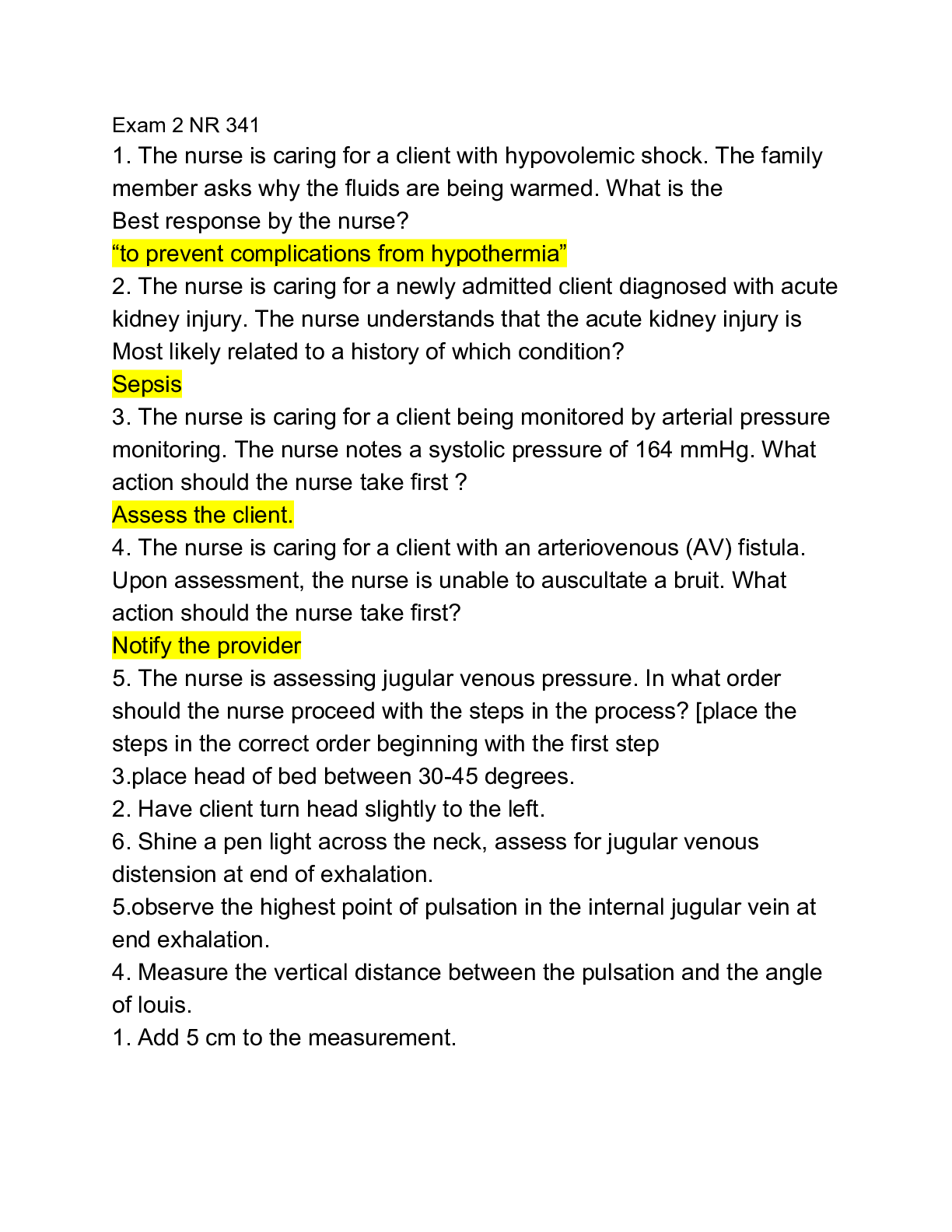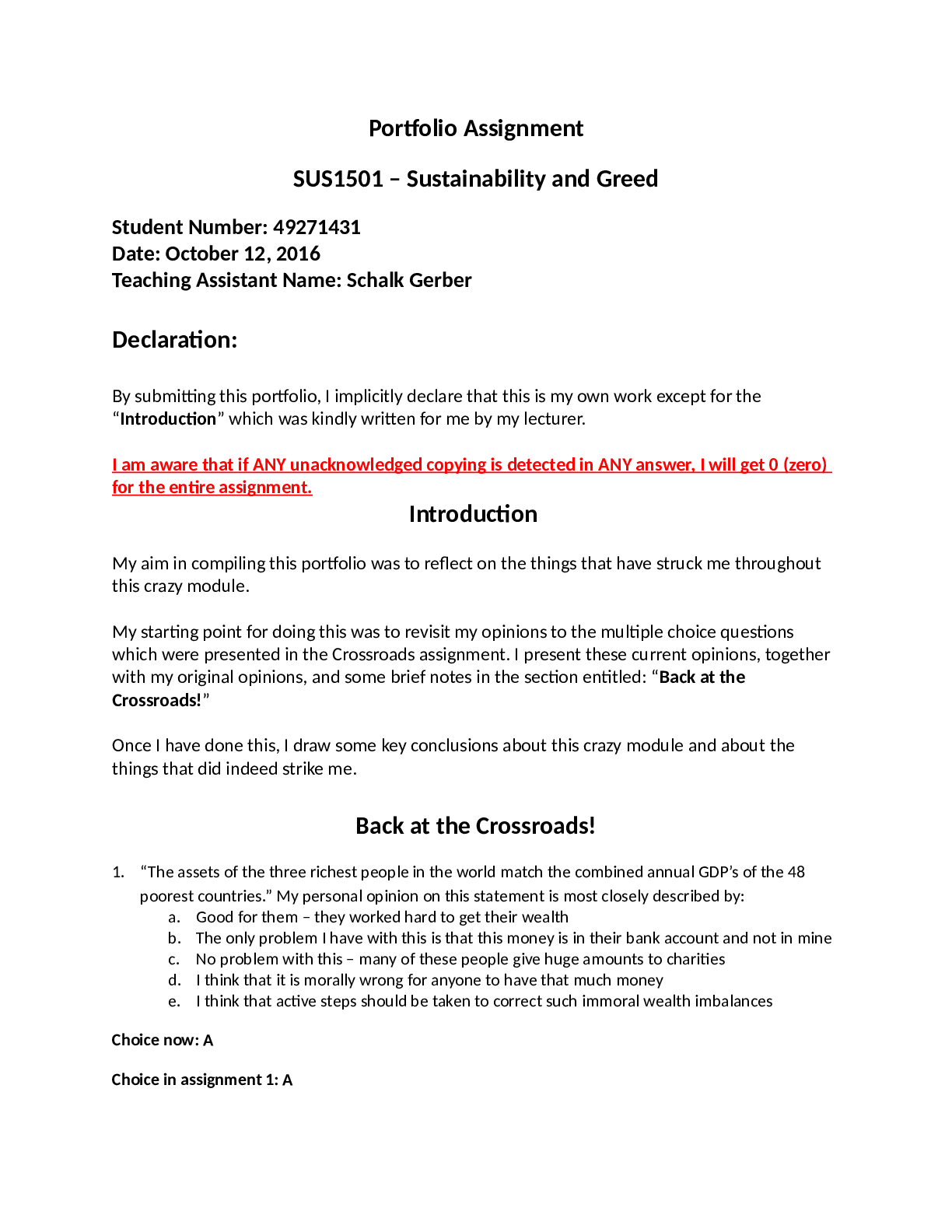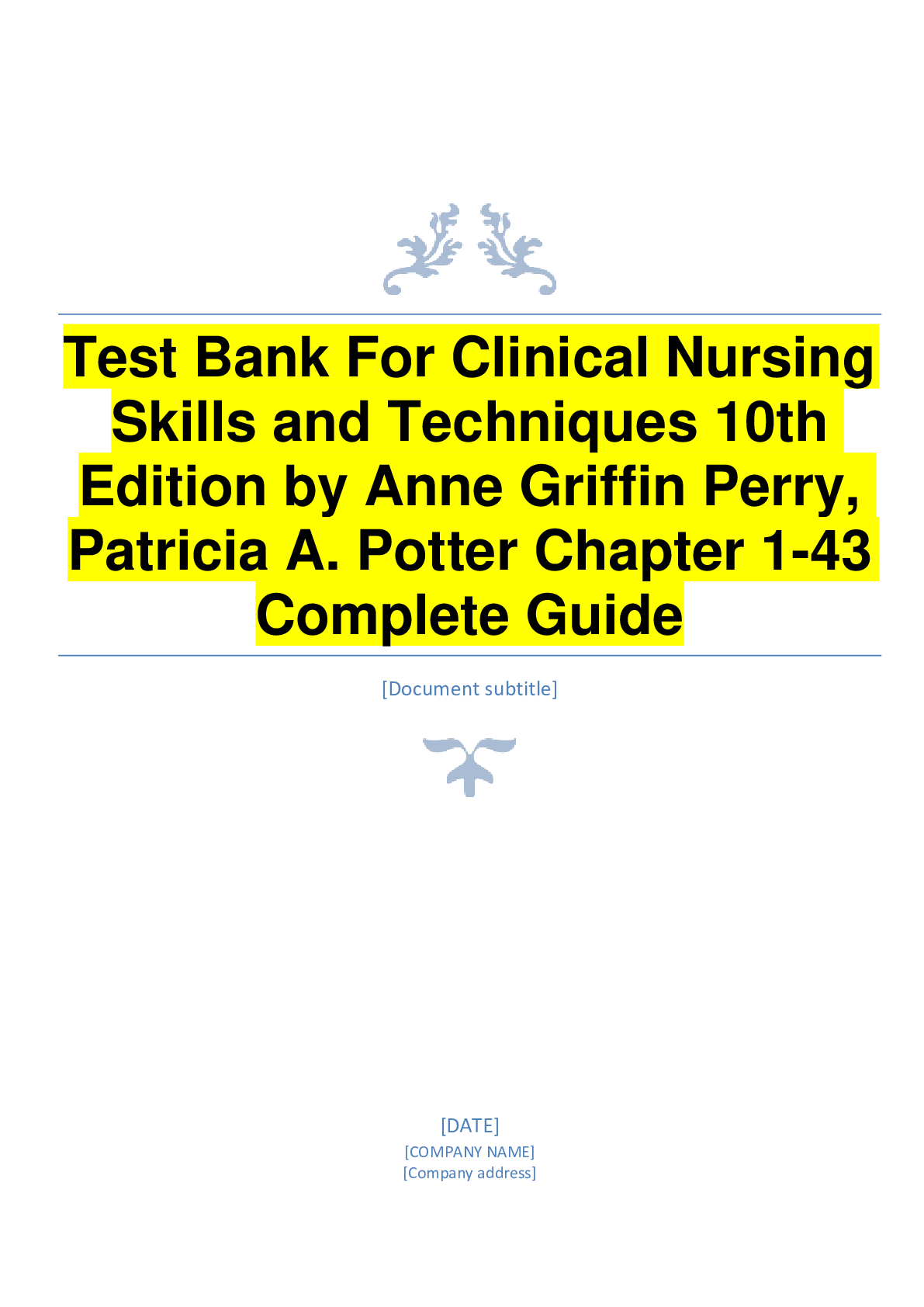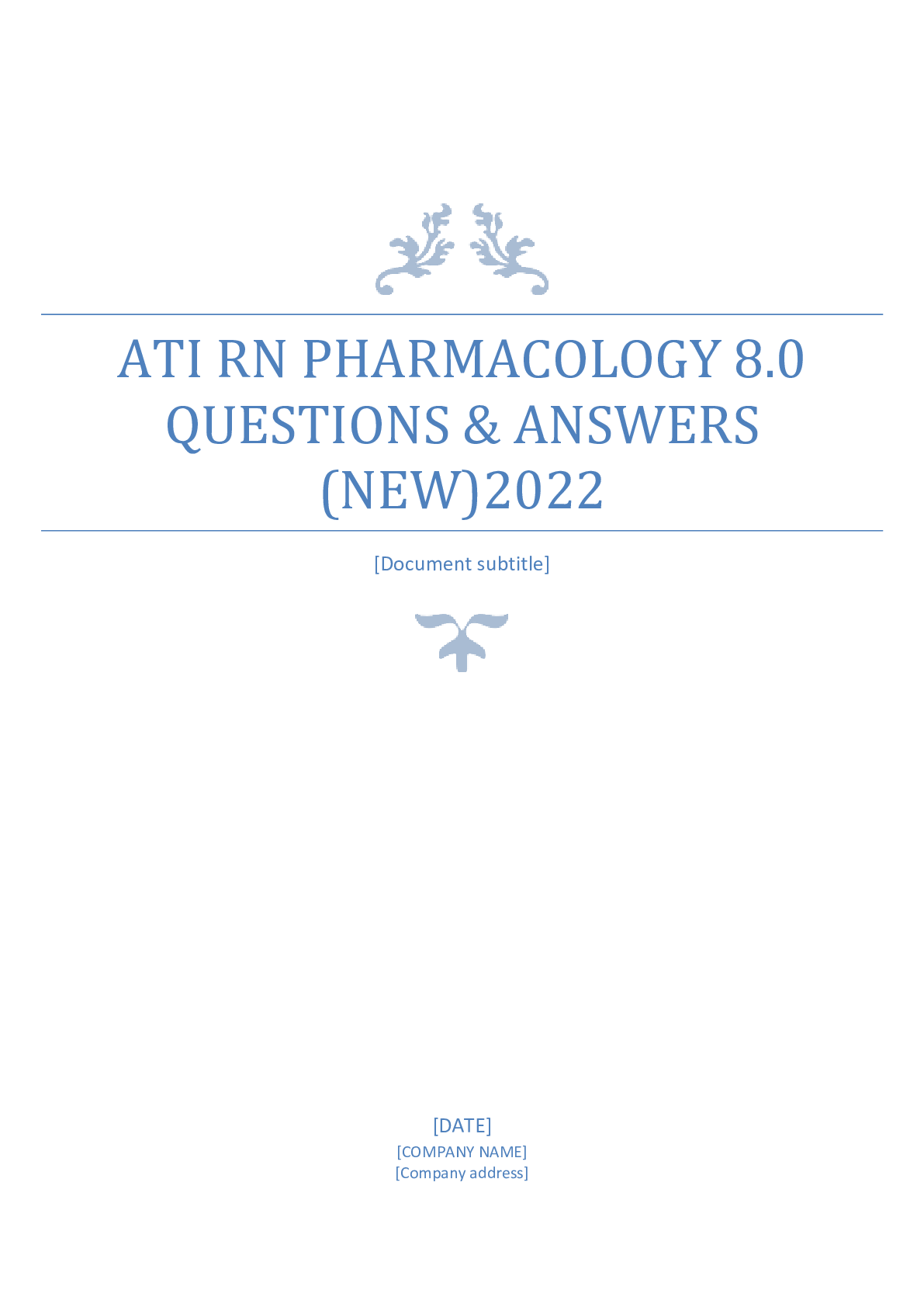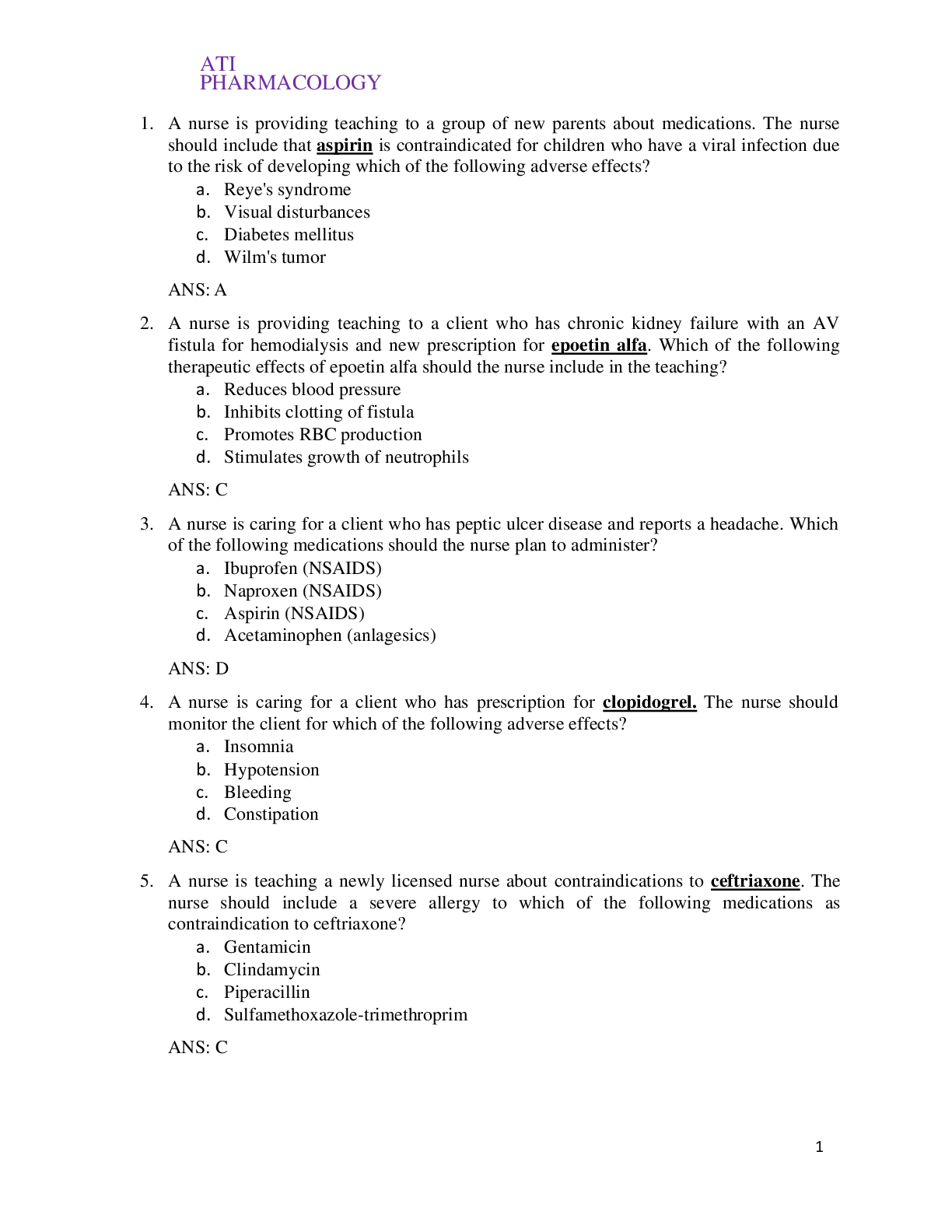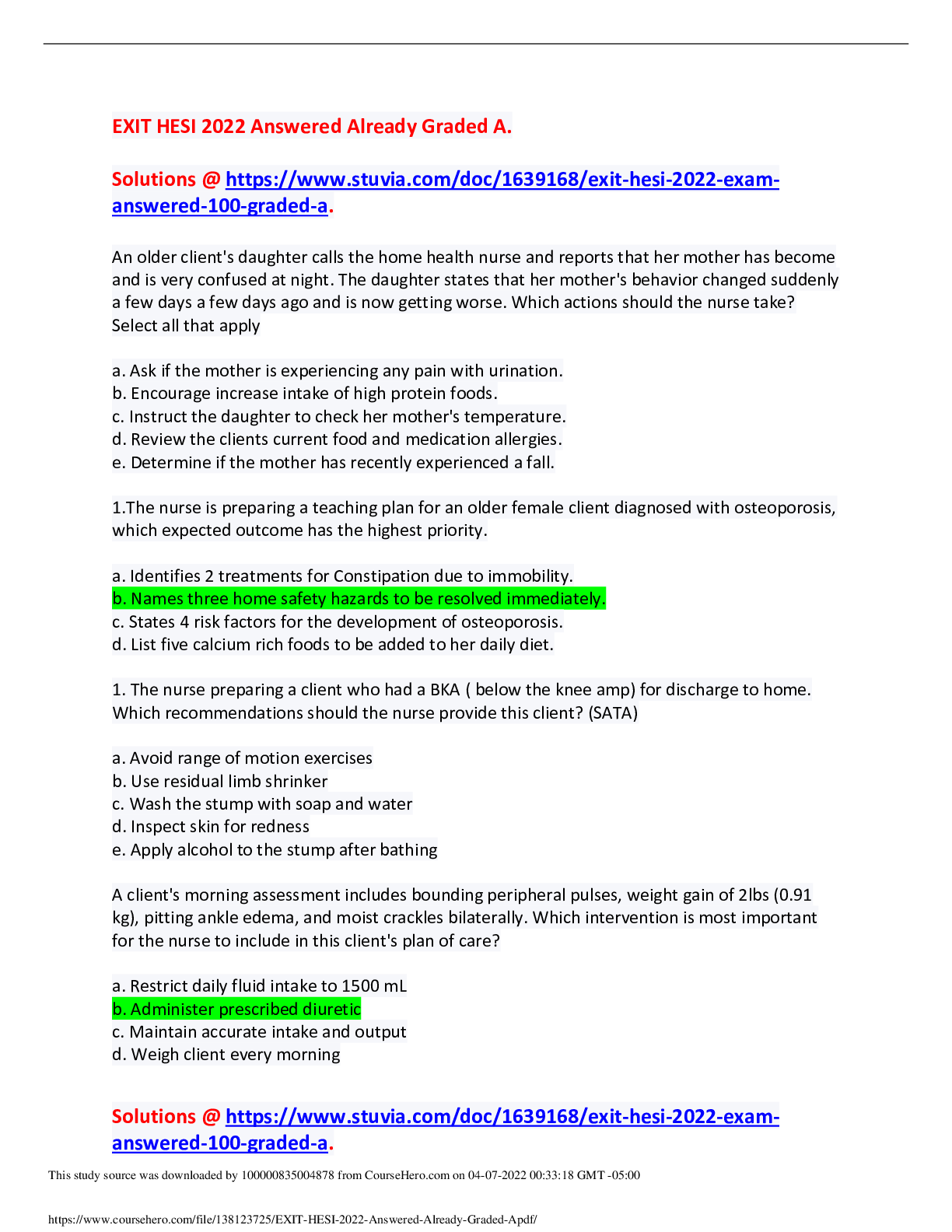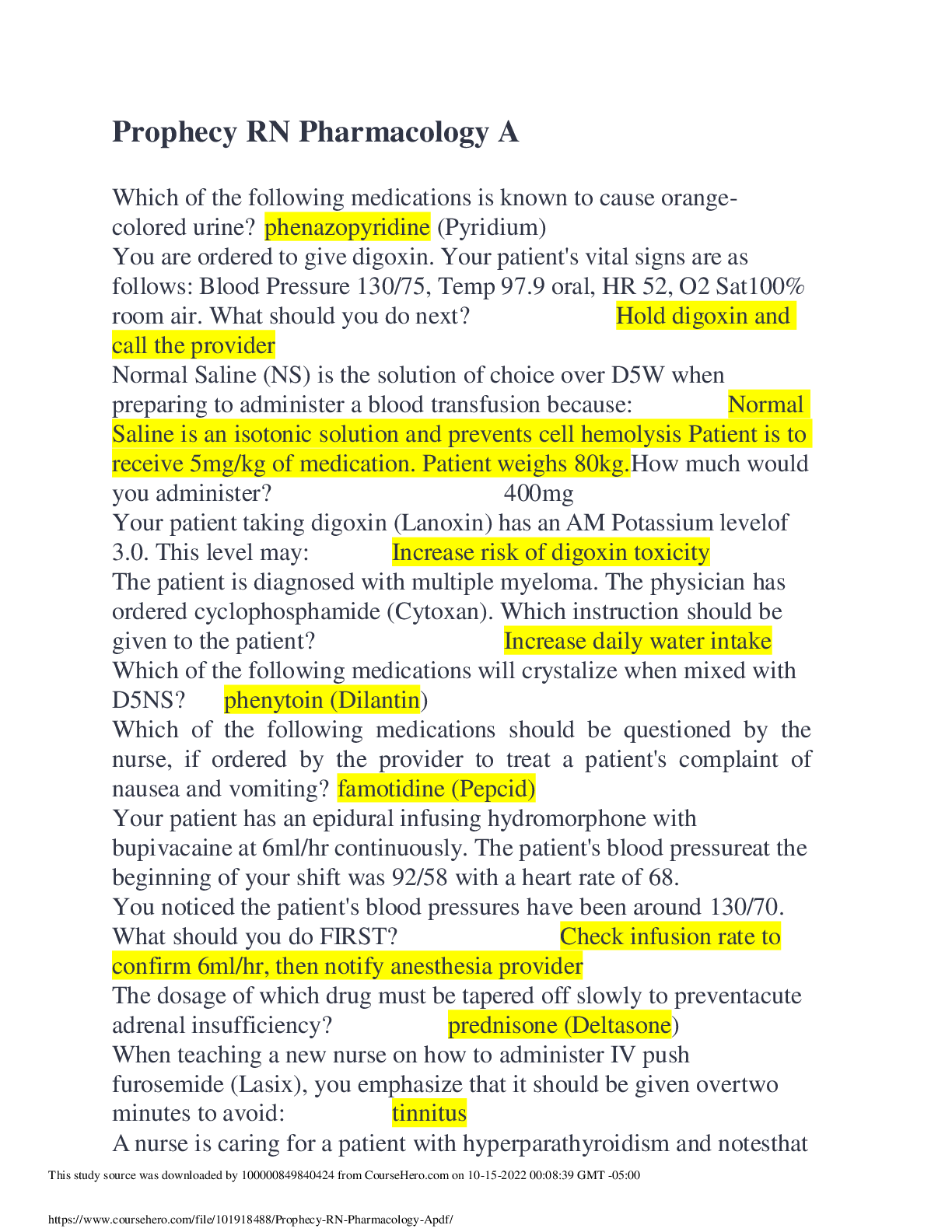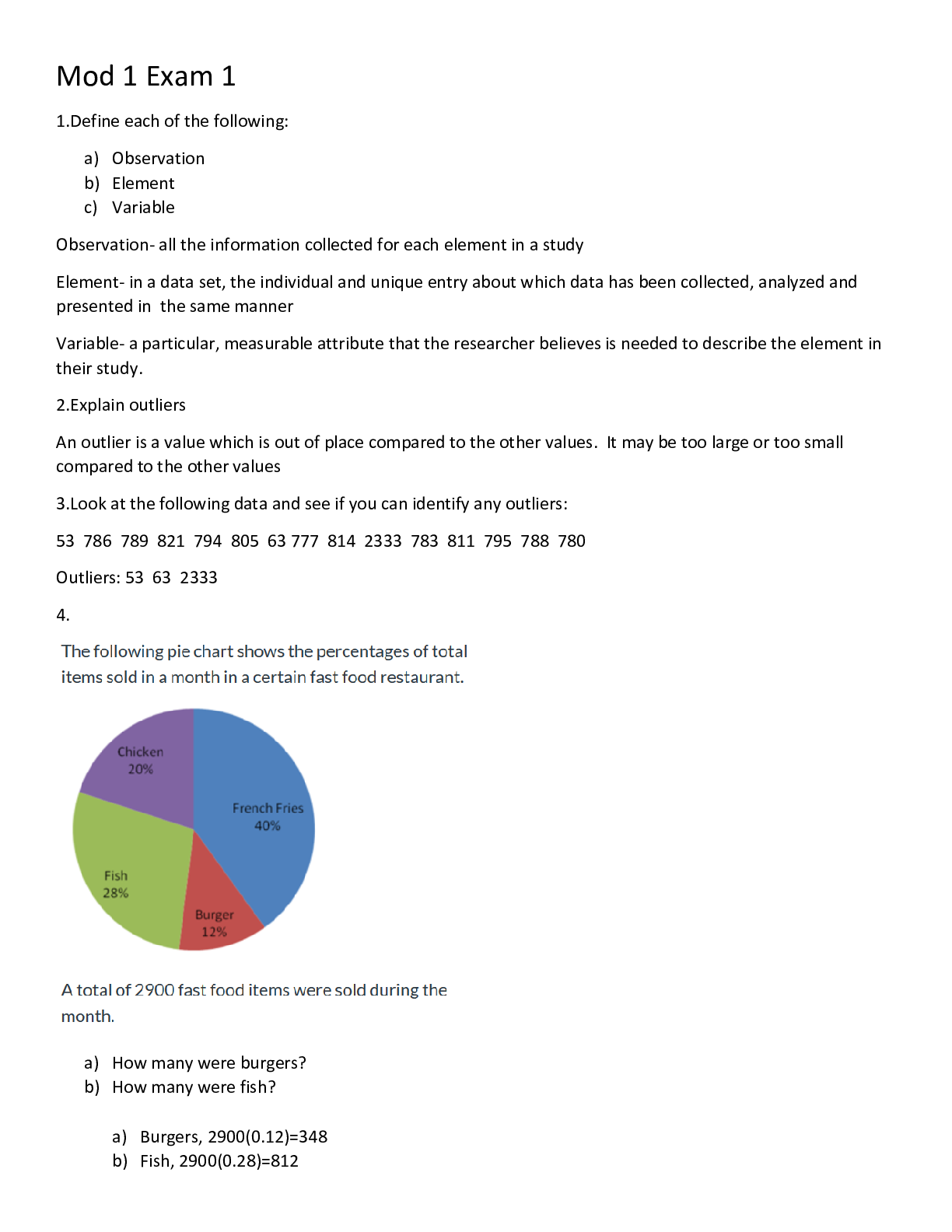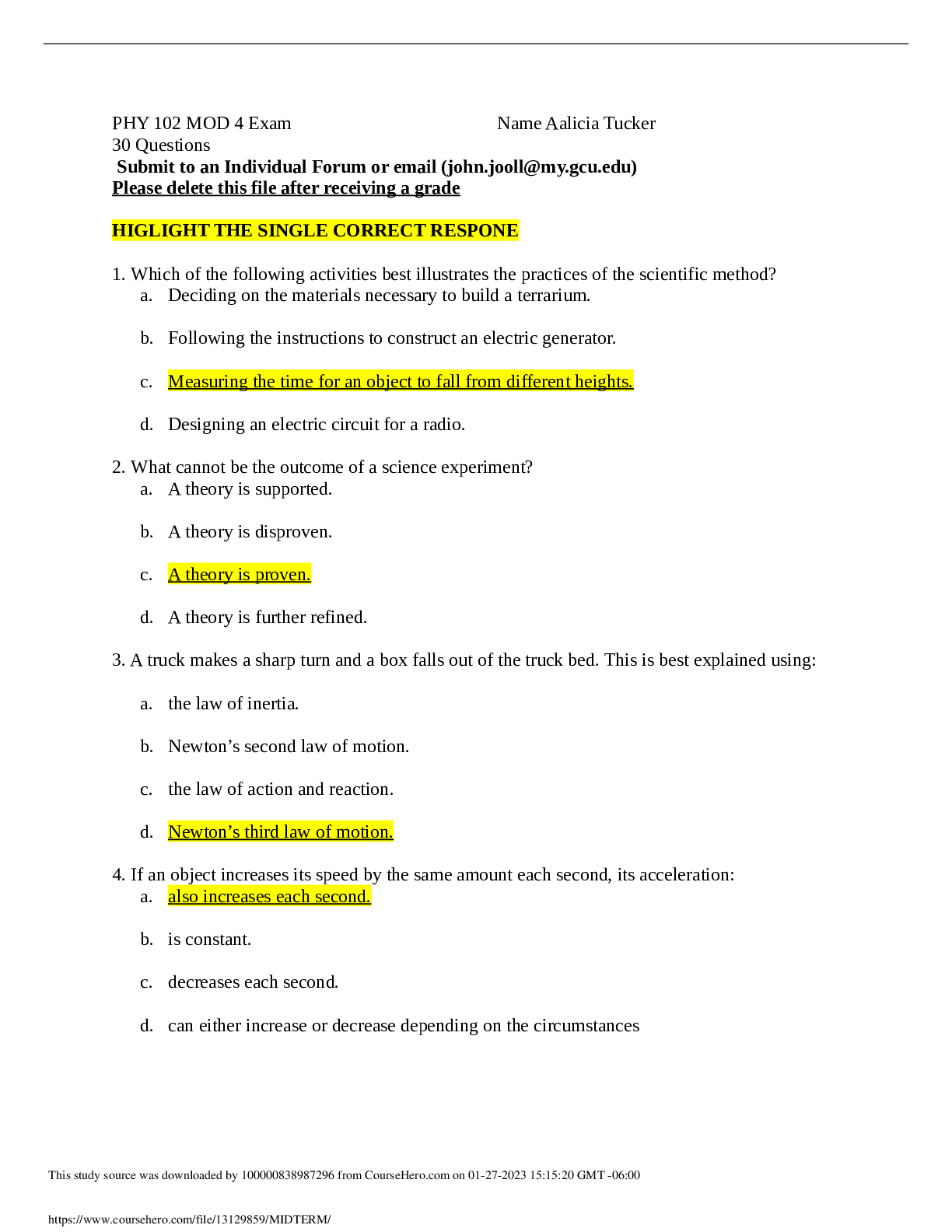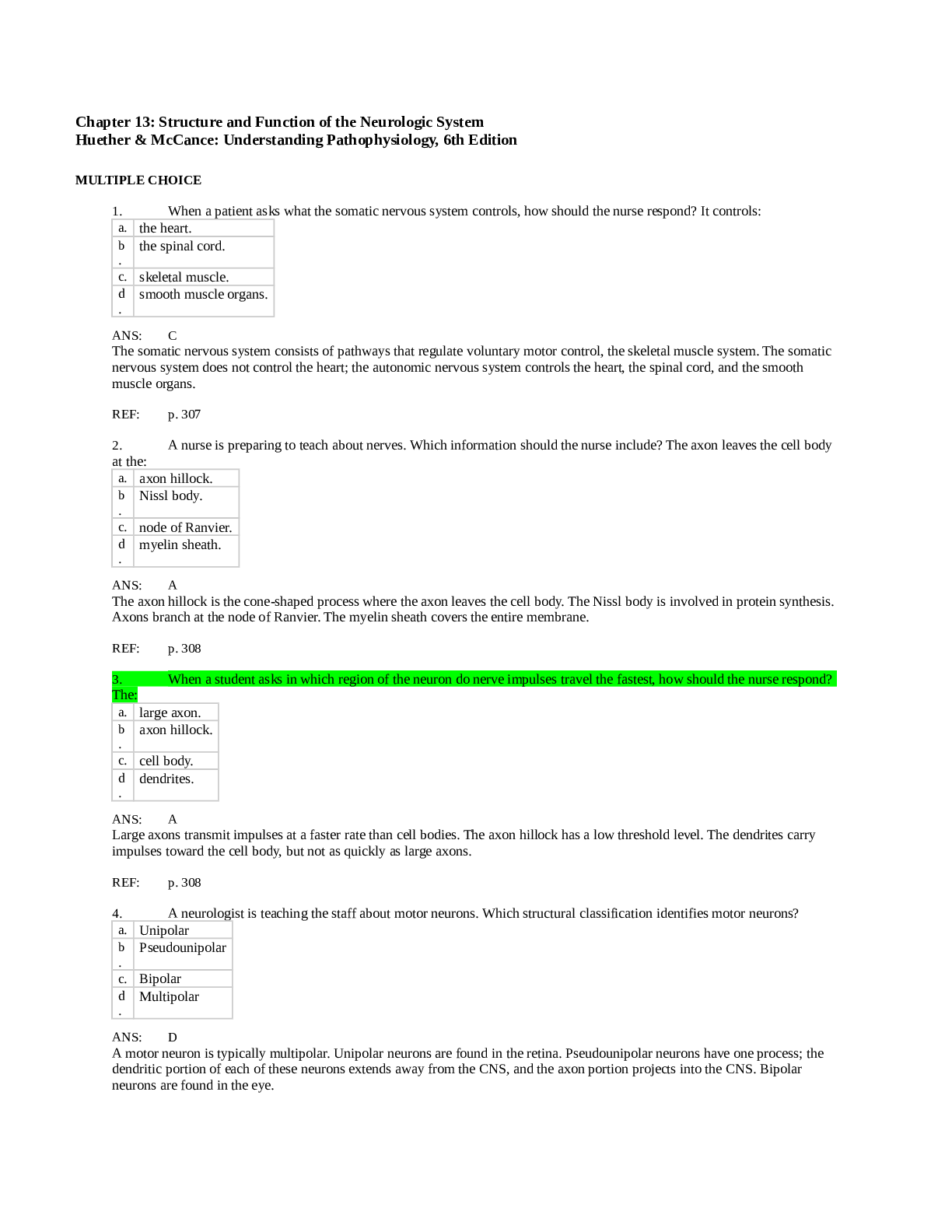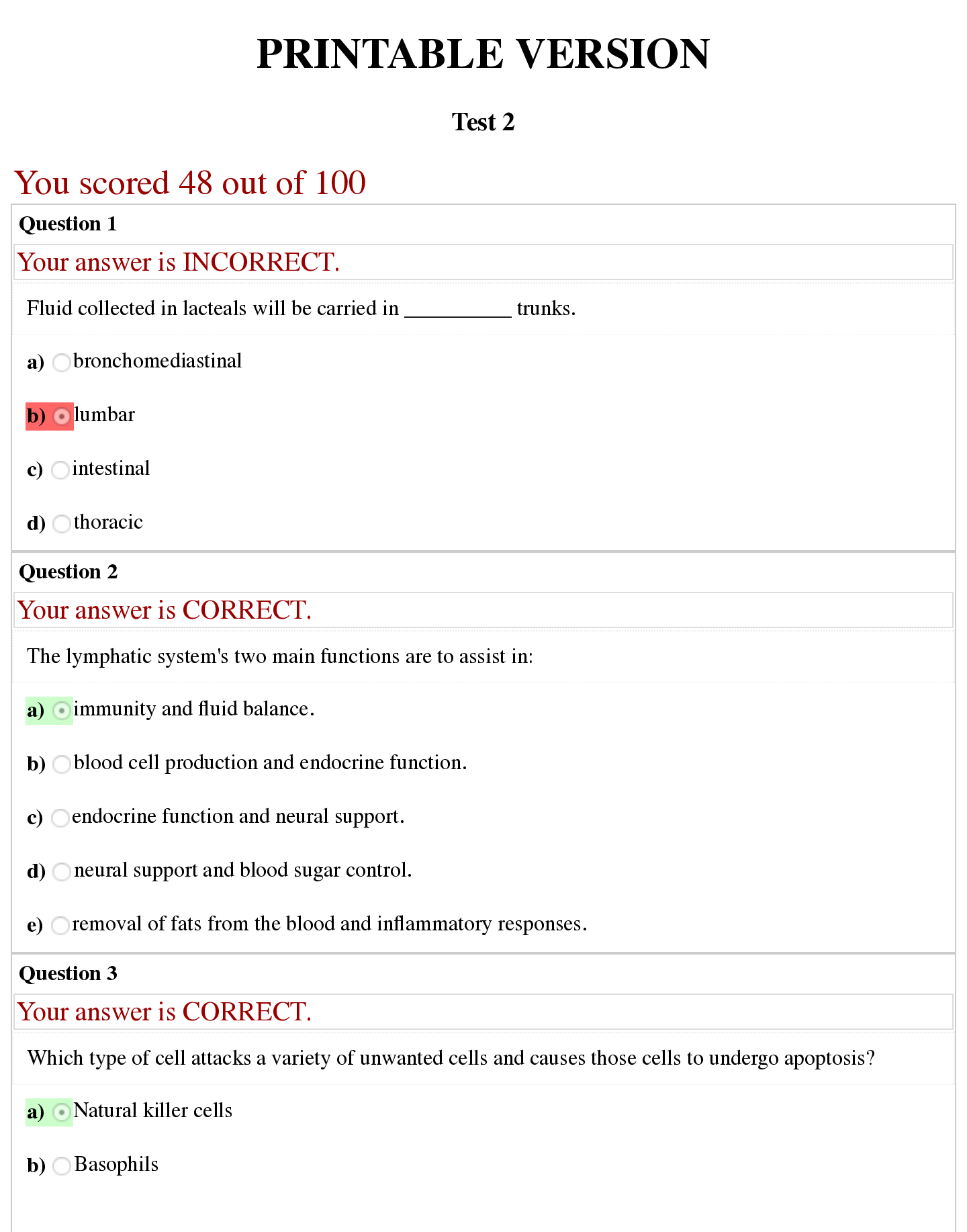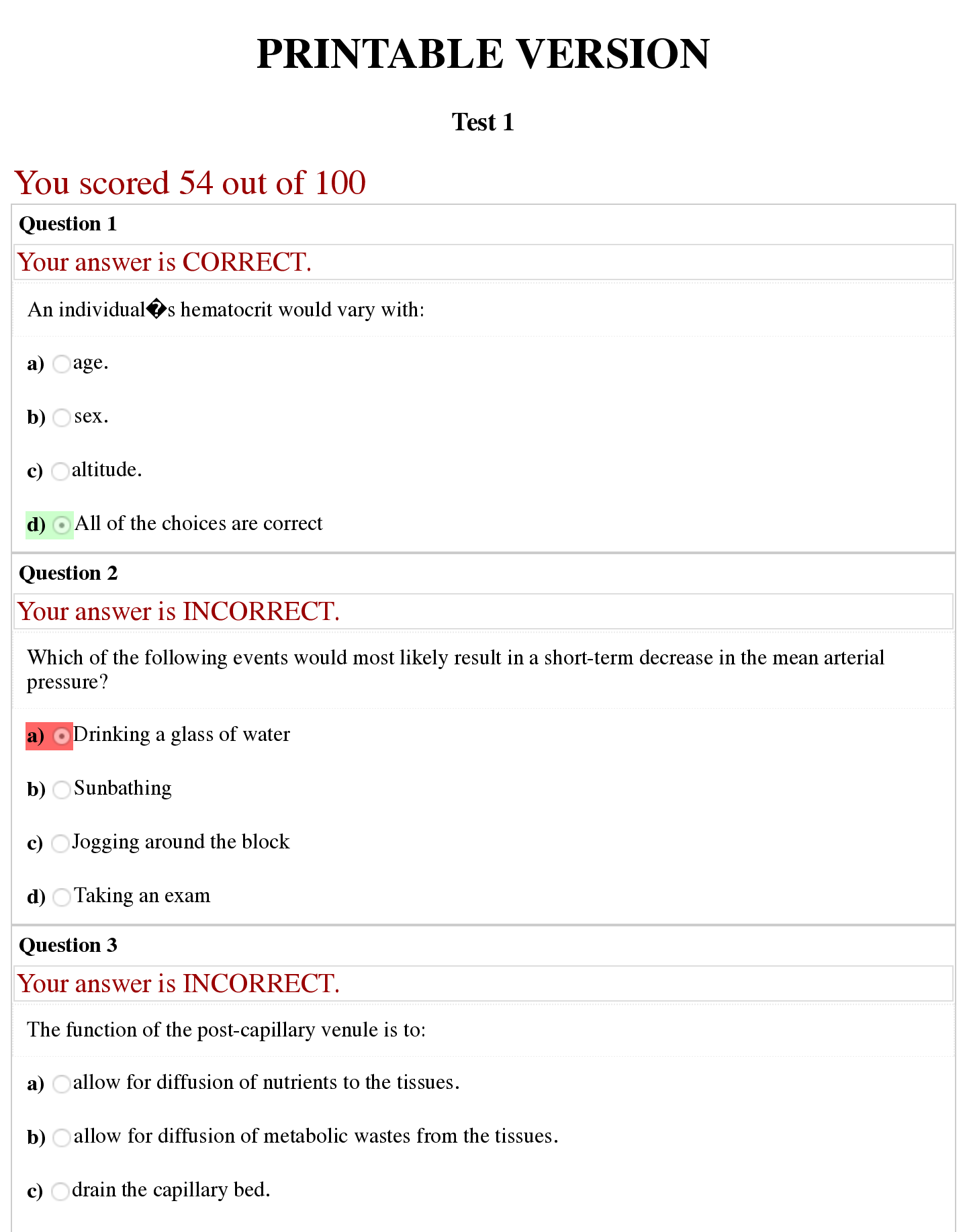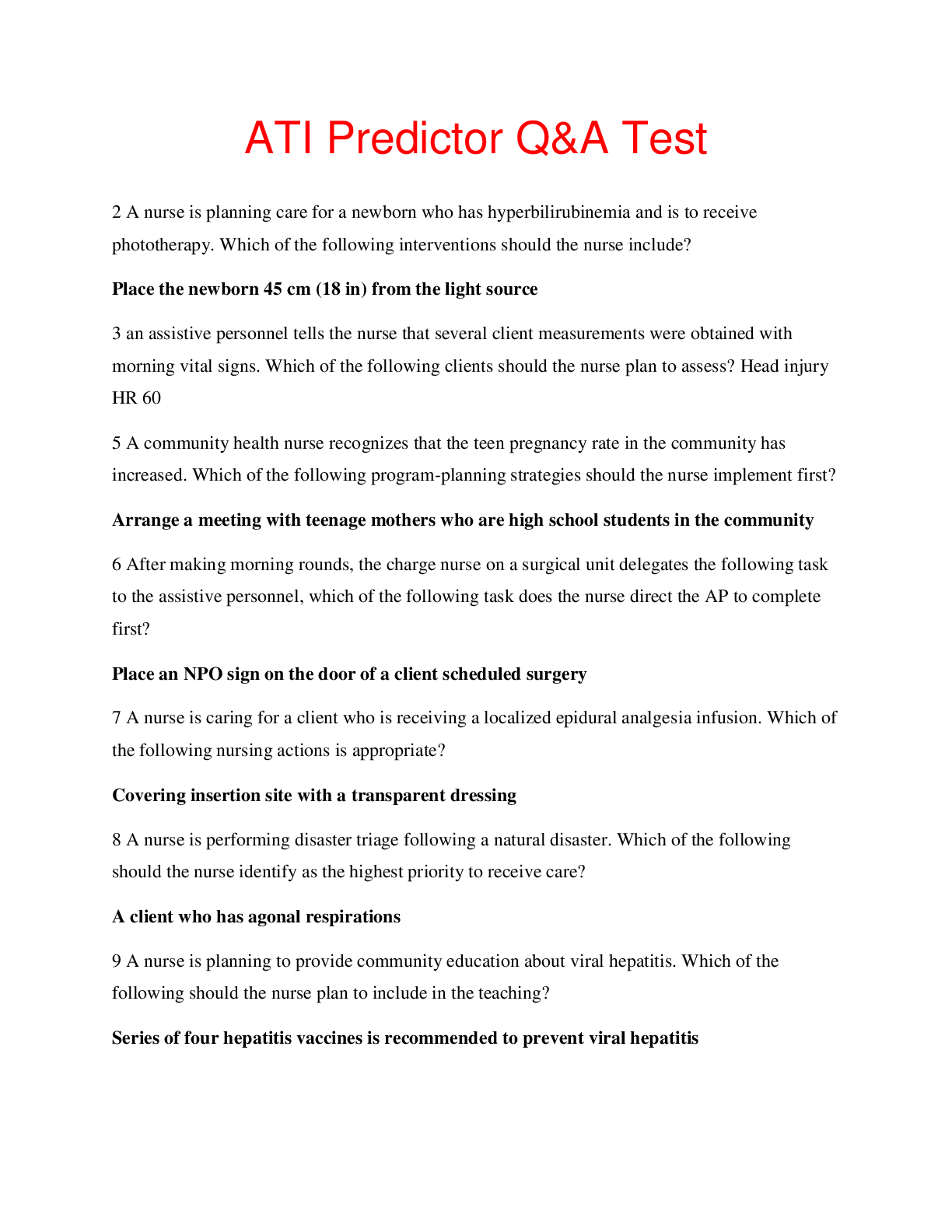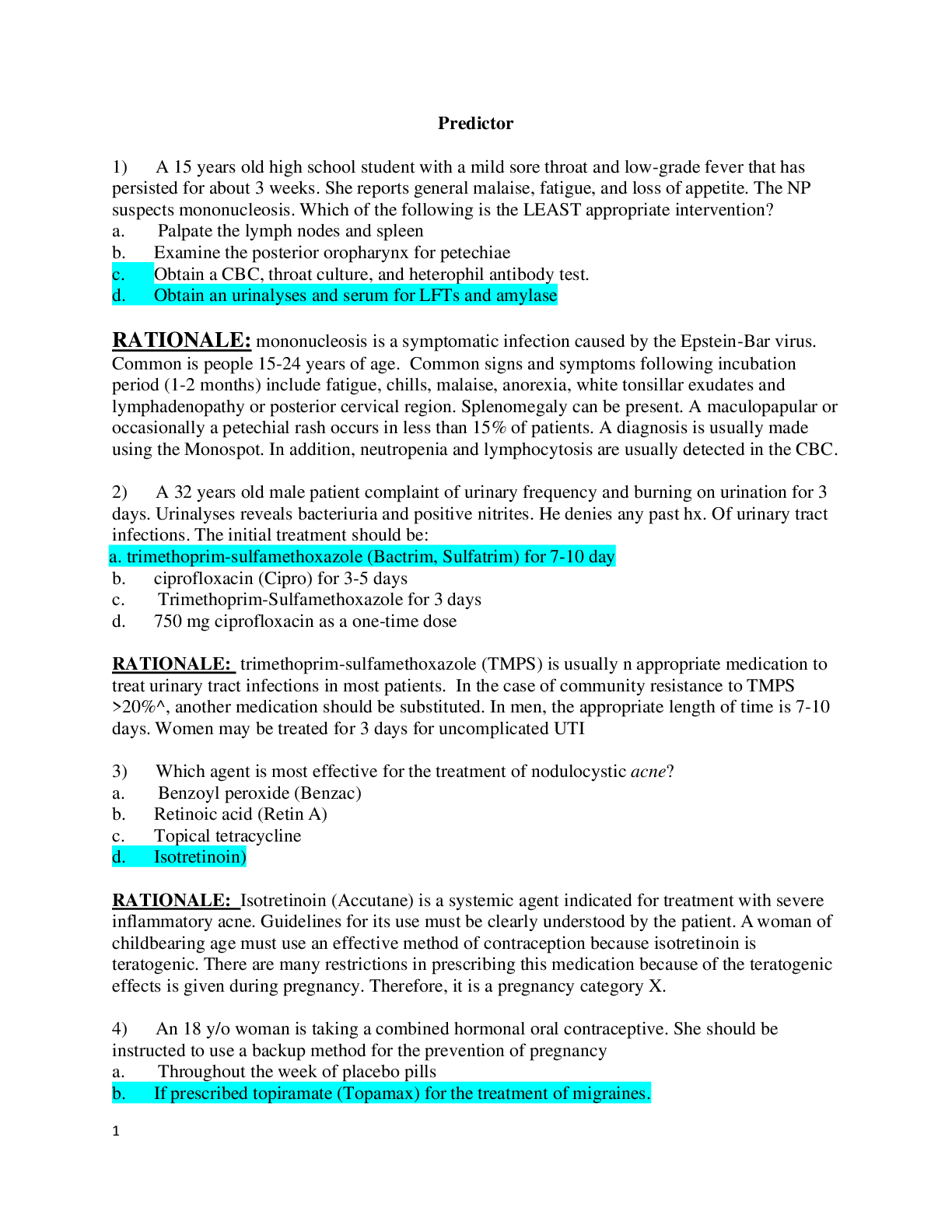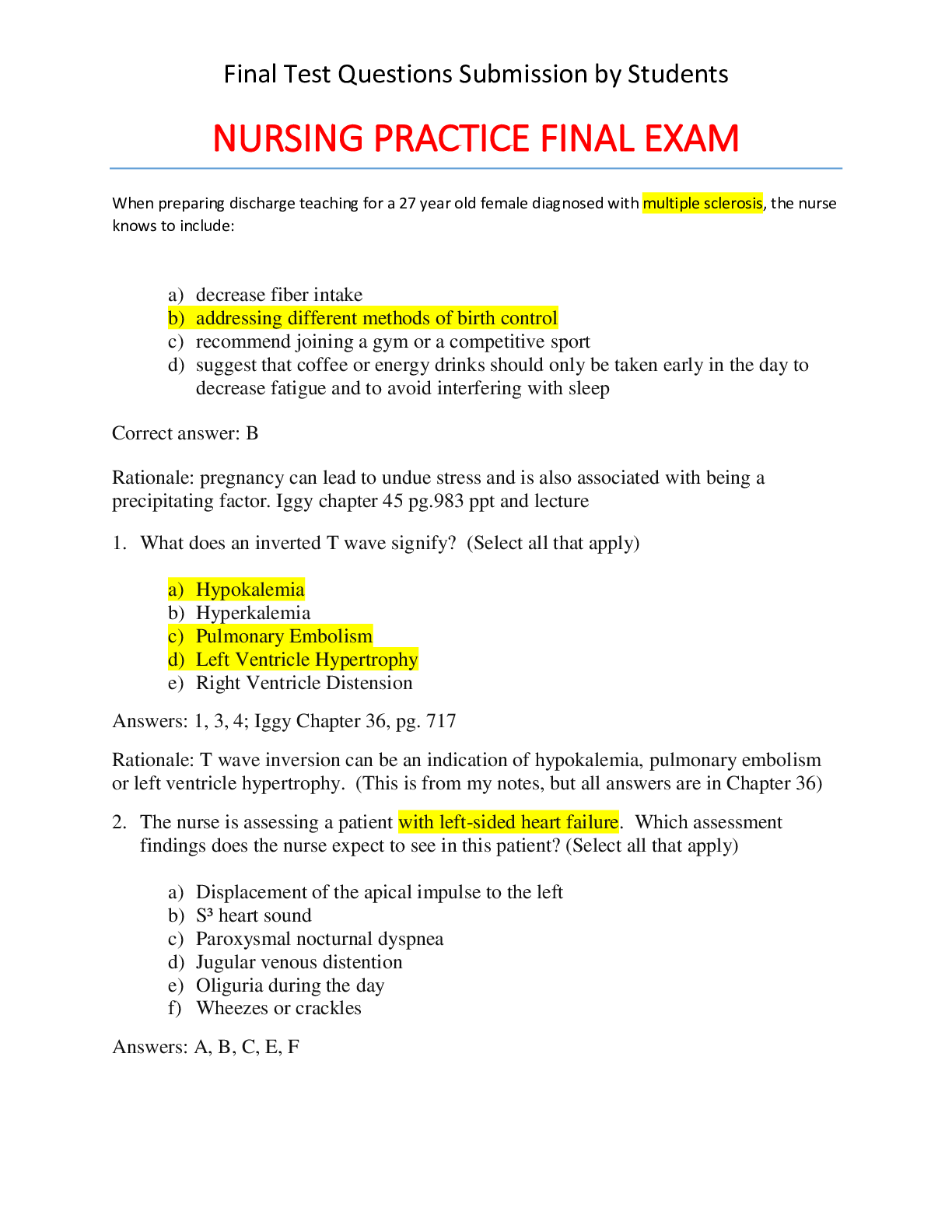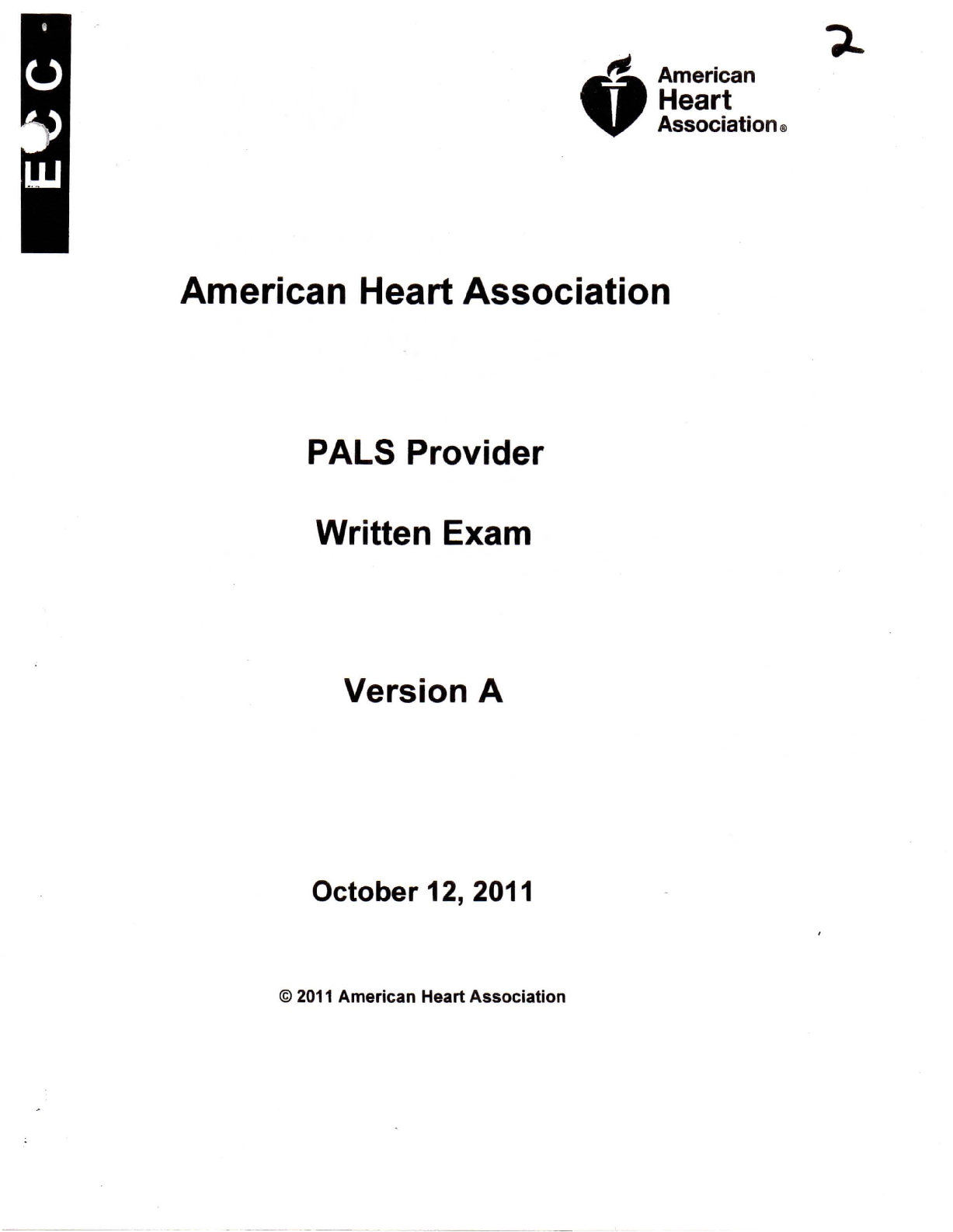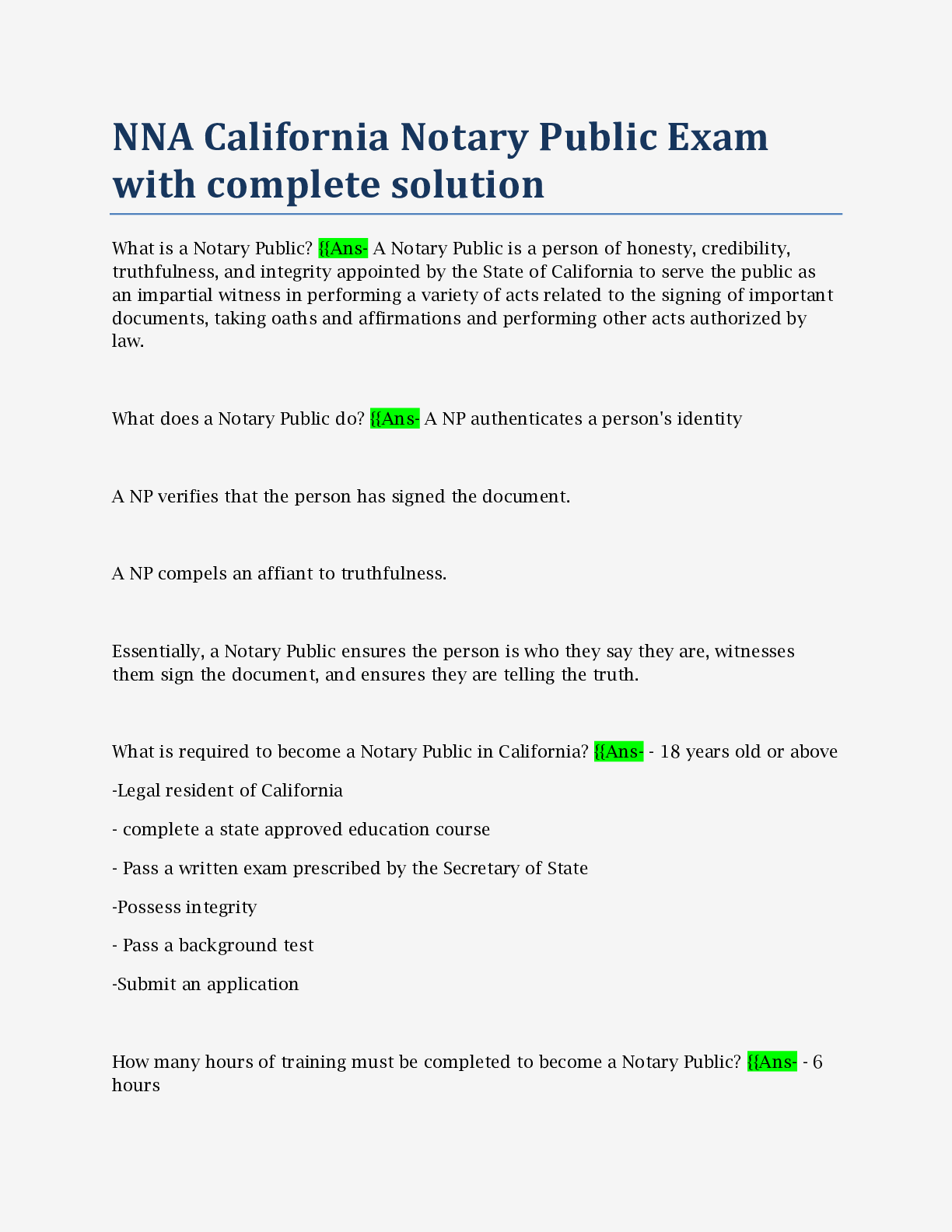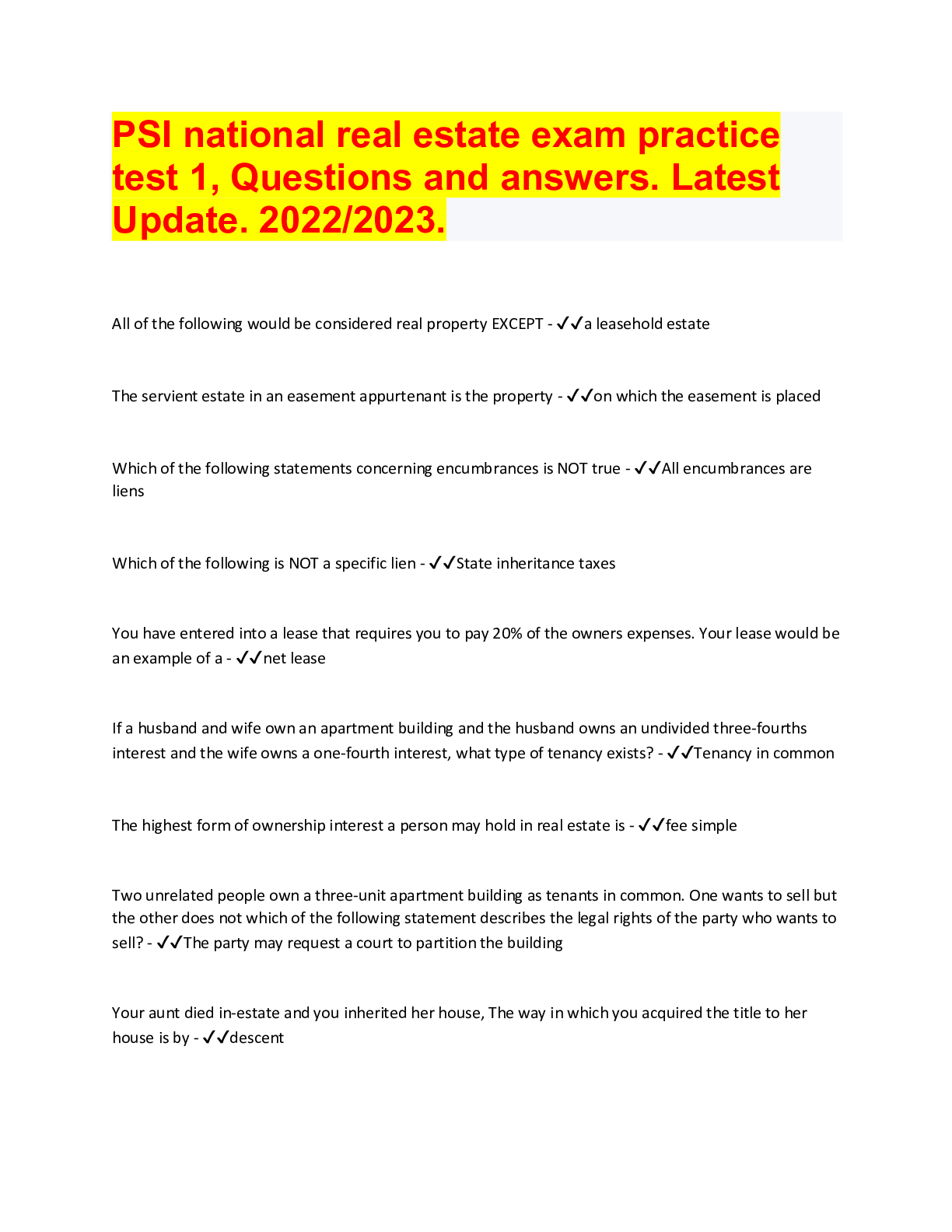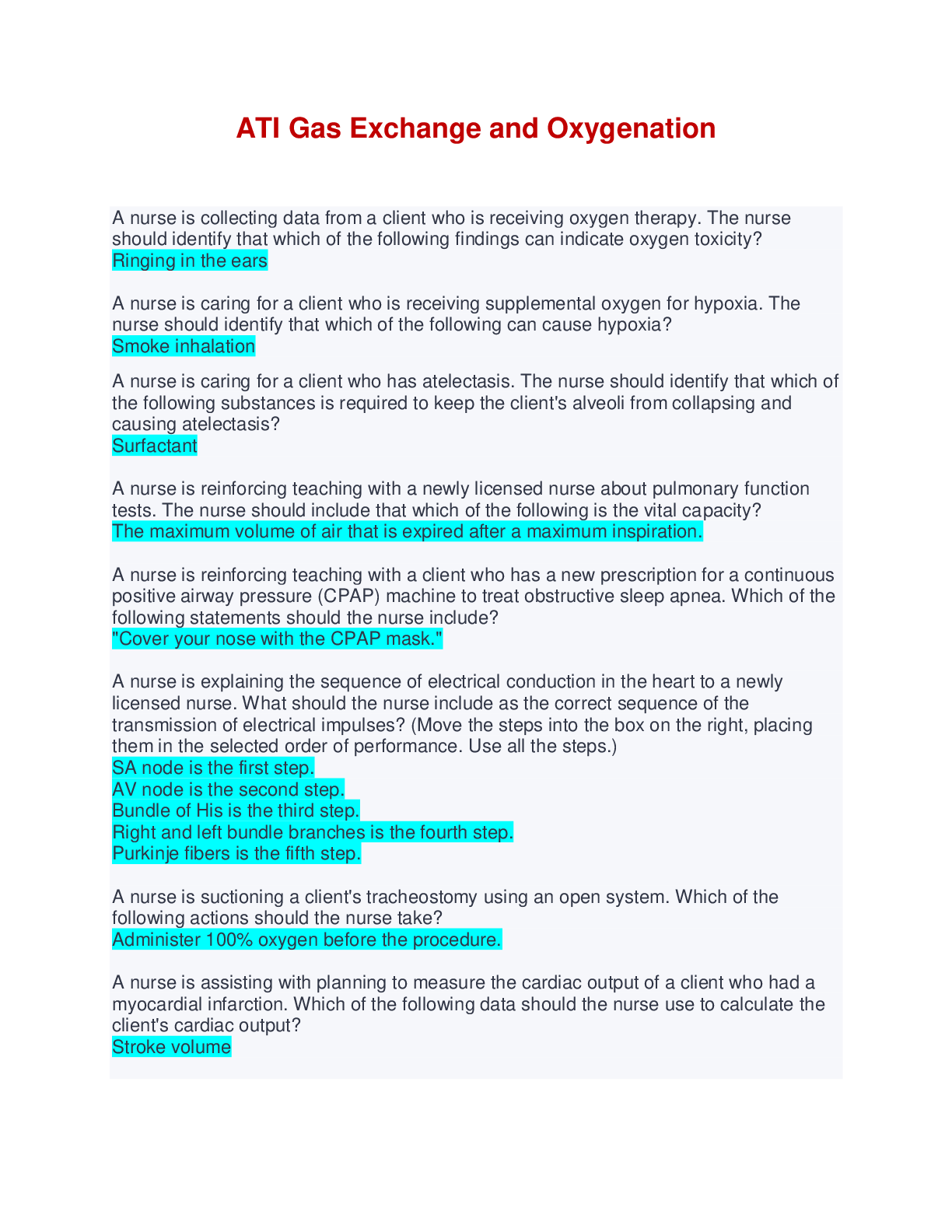NSG 6440 Predictor test Latest 2021
Document Content and Description Below
Predictor test 1) A 15 years old high school student with a mild sore throat and low-grade fever that has persisted for about 3 weeks. She reports general malaise, fatigue, and loss of appetite. The N... P suspects mononucleosis. Which of the following is the LEAST appropriate intervention? a. Palpate the lymph nodes and spleen b. Examine the posterior oropharynx for petechiae c. Obtain a CBC, throat culture, and heterophil antibody test. d. Obtain an urinalyses and serum for LFTs and amylase Explanation: mononucleosis is a symptomatic infection caused by the Epstein-Bar virus. Common is people 15-24 years of age. Common signs and symptoms following incubation period (1-2 months) include fatigue, chills, malaise, anorexia, white tonsillar exudates and lymphadenopathy or posterior cervical region. Splenomegaly can be present. A maculopapular or occasionally a petechial rash occurs in less than 15% of patients. A diagnosis is usually made using the Monospot. In addition, neutropenia and lymphocytosis are usually detected in the CBC. 2) A 32 years old male patient complaint of urinary frequency and burning on urination for 3 days. Urinalyses reveals bacteriuria and positive nitrites. He denies any past hx. Of urinary tract infections. The initial treatment should be: a. trimethoprim-sulfamethoxazole (Bactrim, Sulfatrim) for 7-10 day b. ciprofloxacin (Cipro) for 3-5 days c. Trimethoprim-Sulfamethoxazole for 3 days d. 750 mg ciprofloxacin as a one-time dose Explanation: trimethoprim-sulfamethoxazole (TMPS) is usually n appropriate medication to treat urinary tract infections in most patients. In the case of community resistance to TMPS >20%^, another medication should be substituted. In men, the appropriate length of time is 7-10 days. Women may be treated for 3 days for uncomplicated UTI 3) Which agent is most effective for the treatment of nodulocystic acne? a. Benzoyl peroxide (Benzac) b. Retinoic acid (Retin A) c. Topical tetracycline d. Isotretinoin) Explanation: Isotretinoin (Accutane) is a systemic agent indicated for treatment with severe inflammatory acne. Guidelines for its use must be clearly understood by the patient. A woman of childbearing age must use an effective method of contraception because isotretinoin is teratogenic. There are many restrictions in prescribing this medication because of the teratogenic effects is given during pregnancy. Therefore, it is a pregnancy category X. 4) An 18 y/o woman is taking a combined hormonal oral contraceptive. She should be instructed to use a backup method for the prevention of pregnancy a. Throughout the week of placebo pills b. If prescribed topiramate (Topamax) for the treatment of migraines. c. If prescribed amoxicillin/clavulanate (Augmentin) for a sinus infection d. if she forgets to take a single dose of the contraceptive Explanation: Anticonvulsant including phenytoin (Dilantin), carbamazepine (Tegretol), primidone (Mysoline), topiramate (Topamax) and oxcarbazepine (Trileptal) reduce the effectiveness of contraceptives. Depo-medroxyprogesterone acetate injections or levonorgestrel-releasing intrauterine devices would be a better method of contraceptive for patients taking anticonvulsants. Most commonly used antibiotics have not been proven to reduce the effectiveness of contraceptives. Rifampin is an exception, and additional …. Be used by women taking this drug and using oral contraceptives, transdermal, or vaginal ring preparations. Additional backup contraception should be used if taking antifungal agents. No additional protection is needed thought the week of placebo pills. Missing one single dose of contraceptive does not require additional protection, missing more than one doses does. 5) A 44 years old female patient has diabetes. Her total cholesterol (TC) is 250 mg/dl (6.5 mmol/L), LDL= 190 mg/dL (4.94 mmol/L), HDL= 25 mg/dL (65 mmol/L), and triglycerides= 344 mg/dL (8.94 mmol/L). What agent have the greatest effect on improving her lipid profile and reducing morbidity and mortality associates with dyslipidemia? a. Niacin (Niaspan) b. Atorvastatin c. Omega 3 fatty acids d. Fenofibrates Explanation: First and foremost, it is essential to educate individuals on a heart-healthy lifestyle. LDL-C is one of the major culprits in the development of atherosclerotic heart disease. The target level of LDL-C is between 50 to 70mg/dl to prevent plaque formation in the blood vessels. Guidelines strongly recommend statin therapy because they primarily lower LDL-C levels, but they also have the secondary effects of lowering triglyceride and increasing HDL-C levels. 6) A 30 years old female comes into a clinic with classic signs and symptoms of appendicitis. The NP fails to refer the patient to a surgeon. The appendix ruptures and the woman die. This is an example of a. Failure of diligence b. Professional liability c. Negligence d. Malpractice Explanation: malpractice, a negligence tort, occurs when a health care professional’s actions fall bellow the appropriate standard of care and hurts the patient. In this case the patient came with sings and symptoms indicating appendicitis and the NP failed to refer the patient.. 7) A NP has recently been hired to work in a fast track facility. The NP employer asked if she has “a problem prescribing medications for emergency contraception.” The NP replies affirmatively. This is: a. Grounds for dismissal b. An ethical dilemma for the NP c. Illegal according to the standards of nursing d. Patient abandonment. Explanation: in this instance, the NP has a difference of opinion with her employer based on her religious or moral belief about providing emergency contraception. This situation is an example of an ethical dilemma. Failure to participate in the provision of care to the patient based on the NP’s beliefs is neither against the law nor a violation of the standards of practice 8) A patient presents with pruritic lesions on both knees. There are visible silver scales. How Should this condition be managed? a. Topical antifungal cream or ointment b. Oral antibiotics c. Topical corticosteroids cream d. Topical anti-fungal/ steroid cream Explanation: Psoriasis is characterized by erythematous papules, as well as itchy, red, precisely defined plaques with silvery scales. Auspitz sings is another common finding. Topical agents containing tar and salicylic acid may be used. Topical steroids, such as betamethasone, may also be ordered. 9) Antidepressant discontinuation syndrome is less likely if the patient a. Is male b. Is less than 35 y/o c. Has taken an SSRI with a short half life d. Gradually tapers SSRI use Explanation: Antidepressant discontinuation syndrome is most often seen in the primary care office in association with SSRI discontinuation, because SSRIs are the most commonly prescribed class of antidepressant medications. Interruption of treatment with an anti-depressant medication is sometimes associated with an antidepressant discontinuation syndrome; in early reports it was referred to as a “withdrawal reaction. Symptoms of antidepressant discontinuation syndrome can include flu-like symptoms, insomnia, nausea, imbalance, sensory disturbances, and hyperarousal. Tapering is recommended by experts. 10) Patient with benign prostatic hyperplasia (BPH) should be taught to avoid which one of the following drug classes? a. Alpha adrenergic antagonist b. Anti-androgen agents c. Tricyclic antidepressant (TCA) d. Sulfonamides Explanation: tricyclic antidepressant should not be used by men with benign prostatic hyperplasia because of the increased risk of urinary retention secondary to the anticholigergic effects of TCAs. 11) Which of the following is the best response to a woman who has just admitted she is a victim of spousal abuse? a. What was if you did to make him angry? b. You must seek refuge immediately c. I am concerned about your safety d. I am going to call a shelter for you Explanation: The first step is to establish trust in the therapeutic relationship. without trust future collaboration, intervention and client outcome cannot be accomplished to facilitate appropriate and safe behavior. The experience of abuse is a traumatic psychological crisis that must be addressed as such. The healthcare providers must emphasize the fact that the victim has not done anything wrong and they must also emphasize the fact that the victim's life and the lives of their children can be in danger if the abuse is not addressed. It will not disappear with a lack of action. An order of protection against the perpetrator is often recommended. 12) For which patient group does the US Preventive Services Task Force recommend routine screening for asymptomatic bacteriuria a. pregnant woman b. Children c. Patients with diabetes d. patients over the age of 70 Explanation: an increased incidence of bacteriuria is found in all the population listed. However, bacteriuria in pregnant women increases the mother…..Also increased is the risk of a pre-term delivery, which then increases perinatal and fetal morbidity and mortality. The recommended it…. 13) What diabetic complications result from hyperglycemia? 1. Retinopathy 2. Hypertension resistant to treatment 3. Peripheral neuropathy 4. Accelerated atherosclerosis a. 1,2,3 b. 2,3,4 c. 1,3,4 d. 1,2,4 explanation: Complications of untreated or uncontrolled hyperglycemia over a prolonged period of time include: Microvascular complications: Retinopathy, Nephropathy, Neuropathy Macrovascular complications: Coronary artery disease, Cerebrovascular disease, Peripheral vascular disease 14) A 6 y/o presents w/ complaints of sore throat and fever for 2 days. He has multiple vesiculated ulcerations on his tonsils and uvula. There are no other remarkable findings. What is the most likely diagnosis? a. Viral pharyngitis b. Herpangina c. Epiglottitis d. Tonsillitis Explanation: Herpangina is a viral infection common in toddlers and young children caused by Coxsackie virus. The clinical findings of numerous, small (1-2 mm) ulcerations on the tonsils and uvula are typical of herpangina. The ulcerations can be very painful but usually resolve in 7 to 10 days. Treatment is symptomatic. 15) A patient has Kawasaki syndrome. Which characteristics would be UNUSUAL? a. Age > 15 years b. Fever > 101 F (38.3 C) c. Exudative pharyngitis d. Painful rash explanation: Kawasaki disease is an acute febrile vasculitis syndrome that evolves inflammation of the blood vessels. This condition often causes cardiac complication in children by damaging the coronary arteries is most prevalent in children of Asian ethnicity. Diagnosis of Kawasaki disease requires presentation of fever and 4 of the following criteria: bilateral bulbar conjunctival injection, oral mucous membrane changes, peripheral extremity changes, polymorphous rash, and cervical lymphadenopathy. 16) According to the JNC 8 guideline hypertension in a 40 y/o can be diagnosed when blood pressure exceeds a. 140/90 b. 130/90 c. 125/85 d. 150/100 Explanation: According to JNC 8 guidelines, hypertension is a sustained elevation of systolic BP greater than or equal to 140 mmHg or diastolic BP greater or equal than 90mmHg, taken from 2 or more readings on 2 different occasions after an initial screening. 17) A 48 y/o female complains of pain and stiffness in her right hip and knee that is mild on awakening in the morning, get worse as the day progresses and is relived with hot baths and ibuprofen. Crepitus is palpated on range of motion of the knee. Signs of inflammation are notably absent. What is the most likely diagnosis? a. Rheumatoid arthritis (RA) b. Gout c. Osteoarthritis (OA) d. Osteoporosis Explanation: Rheumatoid arthritis is characterized by several joint deformities, usually bilaterally symmetrical. RA is characterized by inflammatory processes, while OA is not. RA and OA are chronic conditions. Gout is characterized by acute exacerbations related to a defect in purine metabolism, increased uric acid production, or decreased uric acid excretion. 18) A 7-year old female patient presents with severe injuries that are inconsistent with the explanation given for them. The nurse practitioner questions the mother about abuse. She admits that her husband, the child’s father, beat the child. How should the nurse practitioner proceed? a. Inform the mother that the abuse must be reported to child protection authorities. b. Counsel the mother that if it happens again it will be reported to child protection service. c. Ask the child what she did to cause the punishment d. Refer the family to the National Domestic Violence hotline. Explanation: An awareness of all the unique presentations of child abuse, subjective or objective, physical, sexual, or neglect, is essential for NPs. Objective findings, such as broken bones, burns, and bruises, may be as a result of an intentional injury from physical abuse or from an unintentional injury as a result of neglect. Both must be considered. Repeated visits to the emergency department, frequent or suspicious injuries, or bilateral or multiple healing fractures are often indicators of physical abuse. Once the diagnosis of child abuse has been made, the primary role of the NP is to ensure the child is safe. If the NP suspect that a child is undergoing abuse, it’s critical to report it—and to continue reporting each separate incidence if it continues to recur. 19) A 1-month-old presents with reported recurrent diarrhea, screaming, and drawing up of the legs followed by periods of lethargy. On physical examination, a “sausage-like” mass in the upper right quadrant of the distended abdomen. Which of the following is the most likely diagnosis? a. Intussusception b. Volvulus c. Crohn’s disease d. Foreign body in the GI tract explanation: Intussusception is one of the most common causes of abdominal obstruction in children prior 2 years of age; is best described as a portion of the intestine which telescope [Show More]
Last updated: 1 year ago
Preview 1 out of 81 pages
Instant download

Instant download
Reviews( 0 )
Document information
Connected school, study & course
About the document
Uploaded On
Sep 07, 2021
Number of pages
81
Written in
Additional information
This document has been written for:
Uploaded
Sep 07, 2021
Downloads
0
Views
82

